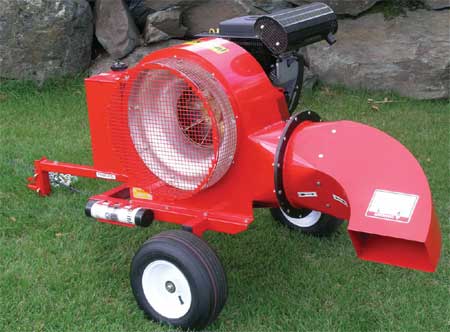Blower Clears Established Firelines in Hardwood Forests Without Disturbing Soil
Equipment Investigated
MTDC conducted a market search for high-volume, self-powered leaf blowers and for sweeping attachments. Basic blowers were available, but they did not have the specialized ducting and nozzles that are needed to deal with rough terrain. One portable unit that looked promising was the Cyclone KB3 debris blower, made by Buffalo Turbine (http://www.buffaloturbine.com, figure 7).

Figure 7—Buffalo Turbine's Cyclone KB3 debris blower.
(Photo courtesy of Buffalo Turbine)
The Cyclone KB3 can put out 10,500 cubic feet per minute of air blown at 180 miles per hour. It has a wireless remote control. The suggested retail price is $6,495 (2009 dollars) for the towable unit (part No. BT-CKB) and $6,345 for the skid-mounted unit (part No. BT-CKBS). Other useful accessories for the Cyclone KB3 include a special order 22½-degree elbow section (part No. MISC 22-degree elbow section) costing $100 (2009 dollars) and a tach-hour meter (part No. 1372) costing $64.96. The Cyclone KB3 comes from the factory with a rigid polymer chute. Aluminum ducting may be substituted at no extra charge.
The Cyclone KB3 debris blower is commonly used on golf courses, but has been used by the United States military in Iraq to clear debris from streets, exposing improvised explosive devices (figure 8). The Cyclone KB3 debris blower also has been used to clear water off the field before major sporting events, including the Super Bowl.

Figure 8—Cyclone KB3 blowers used to clear debris when checking for
improvised explosive devices in Iraq. (Photo courtesy of Buffalo Turbine)
Other high-performance units considered included the BWT 180 and BWF 180 gas engine debris blowers (figures 9 and 10). These units, made by AgriMetal Co., are rated at 10,000 cubic feet of air per minute blowing at 150 to 160 miles per hour. The BWT 180 blower costs $6,285 plus freight (2009 dollars). The BWF 180 blower costs $6,535 plus freight.

Figure 9—AgriMetal's BWT 180 high-performance blower pulled as a
trailer. (Photo courtesy of AgriMetal)

Figure 10—AgriMetal's BWF 180 front-mounted high-performance blower.
(Photo courtesy of AgriMetal)
Many different sweeping attachments are commercially available for smaller equipment platforms (figures 11 and 12).

Figure 11—M-B Co. Model SHL sweeper, 6-foot unit, list price $5,725
(2009 dollars, photo courtesy of M-B Co.)

Figure 12—M-B Co. Model MCD-UV sweeper, 6-foot unit, list price
$5,635 (2009 dollars, photo courtesy of M-B Co.)
A few companies make rotary broom attachments, including Sweepster (http://www.sweepster.com), York Modern Corp. (http://www.yorkmodern.com), and M-B Co., Inc. (http://www.m-bco.com). Some of these attachments require a machine that can provide a significant hydraulic oil flow. The Shawnee National Forest sometimes pushes over small trees when clearing fireline. If anything is mounted on the front of the machine, the attachment must be properly guarded and not get in the way when the machine is crossing steep, narrow gullies.
Some robust towable sweepers are available. The M-B Co. offers a sweeper that has a self-contained hydraulic power system (Model 53MH, 8-foot unit, list price $28,050, 2009 dollars) and one that can be powered by a chain drive (Model 53T, figure 13) off the attachment's tires.

Figure 13—Model 53T tow-behind self-powered sweeper, 7-foot unit, list
price $24,355 (2009 dollars, photo courtesy of M-B Co.).
Trailers are not likely to be suitable for the Shawnee National Forest because the equipment needs to cross steep, narrow gullies. MTDC considered modifying the sweeper's trailer so it would be attached directly to a framework in the bed of the IHI IC-30 crawler carrier. The framework would have a cylinder to raise and lower the unit as needed. The cylinder would tap into the IC-30 crawler carrier's hydraulic system. This arrangement might shorten the length of the equipment (prime mover and attachments), but probably not enough to allow the equipment to maneuver through tightly spaced trees. If a high-volume blower was needed to help finish clearing fireline, there may not be enough room to mount the blower and the hydraulic cylinder needed to raise and lower the sweeper.
MTDC considered using a trail maintenance rock rake (heavy tined York Rake) to clean the fireline. MTDC has designed and fabricated a remotely adjustable ATV rake (figure 14). The Shawnee National Forest staff present during the site visit thought the rock rake might damage waterbars. Logs under the leaf litter also would present problems for a rock rake.
Emanuel Hudson, regional soils and watershed improvement manager for the Forest Service's Southern Region, told MTDC that the Kisatchie National Forest (Frank Yerby, Winn Ranger District) has developed a prototype prescribed fireline maintenance tool called the Fire Break Rake (figure 15). The rake, which is not powered, uses two wheels of a six-wheel hay rake to cast needles and leaves to the side of a previously constructed fireline. A private fabrication shop reworked the original three-point hitch attachment's frame so the wheels are positioned directly behind a farm tractor. A video sent to MTDC appeared to show that the forward speed of the tractor has a bearing on how well the rake wheels move the material. This could be an issue on some of the hardwood prescribed firelines in Illinois. Although the Fire Break Rake is an interesting, low-cost approach, the Shawnee National Forest did not want to pursue using the Fire Break Rake.

Figure 15—The Fire Break Rake being used at the Kisatchie National Forest.
After reviewing the prime movers available on the Shawnee National Forest, the operational constraints, and the attachments identified in the market search, MTDC purchased the Cyclone KB3 debris blower from Buffalo Turbine and adapted it for use in the bed of a Polaris Ranger UTV owned by the Shawnee National Forest.


